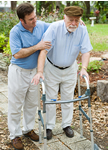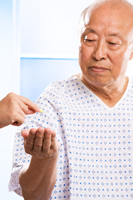Pain After Stroke

 Pain is common after a stroke. Pain means that the body is hurt or something is wrong. Every stroke survivor's pain is different. The pain may be mild or severe. It may last for a short time or be constant.
Pain is common after a stroke. Pain means that the body is hurt or something is wrong. Every stroke survivor's pain is different. The pain may be mild or severe. It may last for a short time or be constant.
What Do You Need to Know?
Pain after a stroke is caused by many things. Your loved one can have one or more types of pain. The key is to find the cause of the pain so it can be treated.
Local Pain
Local pain results from physical problems. After a part of the body is paralyzed (unable to move) or weakened, the muscles may become tight and stiff. These changes in the muscles can cause pain. This pain is often felt in the joints, most often in the shoulders. Your loved one may also have sore muscles from learning new ways to walk or move. Pain may be caused by lying or sitting in one place too long. Other common causes are pressure sores or painful leg cramps at night.
Central Pain
Central pain is a direct result of damage to the brain from the stroke. Sensations like light touch are felt as pain when they should not be painful. This pain is described as burning or aching. The pain is usually on the side of the body affected by the stroke. It is often constant and may get worse over time. Changes in cold and hot temperatures may increase the pain. Movement or touching may increase the pain.
Why Is It Important to Get Help?
Talk to the healthcare team about your loved one’s pain. Pain often leads to other problems. For instance, pain can cause depression and loss of sleep. Your loved one may stop moving a painful part of the body. Over time, the joint of this body part may “lock up” and your loved one will lose movement.
What Treatments Should You Discuss with Your Healthcare Team?
Pain usually lessens with treatment. There are many treatments to ask about.
Pain Medicines 
Pain medicines are one of the most important treatments. Use pain medicines that your healthcare team suggests. Follow the directions on the label of the medicine. Give pain medicines on a regular basis. Do not wait until the pain gets bad to give pain medicines.
Over-the-counter (OTC) pain medicines, like Tylenol®** or Advil®** relieve mild pain. These OTC medicines may interact with other medicines your loved one takes. Check with your healthcare team before taking any OTC medicines.
Medicines used to treat depression, spasticity (tightness and stiffness of muscles) or seizures may relieve central pain. Shots or injections of cortisone (steroids) into joints like the shoulder may help.
Exercises
Exercises to strengthen muscles can help your loved one move better. For example, stretching exercises decrease the tightness and soreness of the muscles. Talk with a physical therapist about the best exercise plan.
Heat Therapy
Heat therapy like heating pads and warm baths may soothe sore muscles and stiff joints.
Electrical Nerve Stimulation
Electrical nerve stimulation (often called TENS or TNS) improves the strength of the muscles and often reduces pain. Patches or electrodes are placed on the skin. A mild electrical current runs through these patches. This is not painful.
Complementary or Alternative Therapies
Complementary or alternative therapies like acupuncture, massage therapy, and yoga often relieve pain.
What if the Pain Continues?
Everyone has the right to good pain control. Ask your healthcare team to try different treatments to relieve the pain. If the pain continues, ask about other types of care.
- Pain clinics are helpful for people whose pain is difficult to treat. Ask about pain clinics in your area.
- Psychologists help stroke survivors find ways to live with pain that cannot be completely relieved. Psychologists also help survivors who are sad or depressed due to living with pain.
How Can You Help Your Loved One Describe the Pain?
Your healthcare team needs to know how your loved one feels. Ask your loved one to rate the pain. Use a pain scale of “0-10,” with “0” being no pain and “10” being the worst pain your loved one has ever felt. If your loved one can’t speak, use a pain scale, like the one below.

From Hockenberry MJ, Wilson D, Winkelstein ML: Wong's Essentials of Pediatric Nursing, http://www.mosbysdrugconsult.com/fcgi-bin/displaypage.pl?isbn=0323025935 ed. 7, St. Louis, 2005, p. 1259.Used with permission. Copyright, Mosby.
Take note of where your loved one hurts. What things bring on the pain? What makes it worse? When does the pain occur? How does it feel? Report these symptoms to your healthcare team. MyHealtheVet has a pain journal you can use to track your loved one’s pain. You must be registered to use this feature.
Remember that some stroke survivors have trouble speaking. Watch for signs of pain such as moaning or changes in behaviors. Some stroke survivors may not feel pain. They may not know when they are cut or burned by hot water. Watch for sores and other injuries.
Talk with Your Loved One About the Pain
- Pain almost always is a real problem. Believe your loved one’s complaints.
- Allow time for your loved one to talk about the pain.
- Talk about feelings of sadness related to the pain. Watch for signs of depression. Report problems to your healthcare team. Learn more about depression after stroke.
Helpful Tips
- Help your loved one remain active to keep muscles strong and reduce pain.
- Talk with your healthcare team about correct ways to exercise. Also ask about how best to position paralyzed or weak arms and legs. Splints or other devices may be helpful.
- Support a weak or paralyzed arm to reduce pain in the shoulder. Ask your healthcare team about using an arm sling. Provide support for the arm on a lapboard or raised armrest. Use pillows while lying in bed.
- Have your loved one wear loose, comfortable clothing.
- Help your loved one relax. Find an activity that your loved one enjoys such as playing with the dog or watching television. Suggest activities like listening to music, reading a book, prayer or meditation.
- Use warm baths, showers, warm washcloths or heating pads. Be sure to check the temperature so as not to cause burns. Cool cloths and ice may also help. Talk with your healthcare team about the best plan.
Remember
- Pain is almost always a real problem. Believe your loved one. Get help for any signs or problems of pain.
- Pain can cause other problems like depression and loss of sleep.
- Treatment is based on what is causing the pain. Ask about the pain. Help your loved one describe the pain to the healthcare team.
- Everyone has the right to good pain control. Ask for different treatments if the pain is not relieved.
More Resources 
Additional credible resources on this topic can be found here. Website pages may change or update, therefore if a link does not work, you may also try to type the information into your internet search bar. This Resource List will be updated frequently.
References: National Stroke Association. (2006). Recovery after Stroke: Dealing with Pain. Retrieved June 10, 2008, from http://www.stroke.org/site/DocServer/NSAFactSheet_Pain.pdf?docID=995 (This resource is no longer available.)
These materials were created for the project:
Web-Based Informational Materials for Caregivers of Veterans Post-Stroke
Project Number SDP 06-327 funded by VA HSR&D Quality Enhancement Research Initiative (QUERI)



















